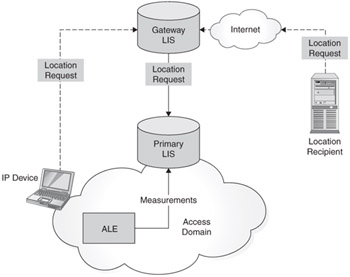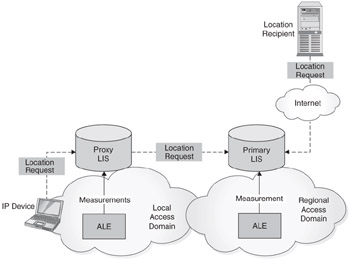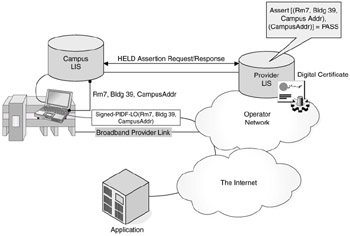Types of LIS
An LIS is categorized based on the functions and services that it is able to provide. Three principle characteristics are used to classify an LIS, and an LIS that supports all of these is referred to as a Primary LIS. These characteristics include the following:
-
The ability to determine location
-
The ability to provide a location reference
-
The ability to provide cryptographically dependable (signed) location.
It should be noted that the ability to determine location includes the ability to support locations being asserted to the LIS.
The Gateway LIS
A Gateway LIS provides a point of contact for location requests without performing any actual location generation. The Gateway LIS does this by setting the location reference (location URI) from which the location of a target can be retrieved. The location URI indicates the address of the Gateway LIS, ensuring that Location Recipients request location from the Gateway instead of the Primary LIS.
A Gateway LIS on its own has no capacity for location generation; it typically exists closer to the public network than the LIS that provides location. The bulk of the location information must be served by another LIS-usually a Primary LIS.
In the configuration shown in Figure 4.14, the Gateway LIS appears to provide all LIS functions to both the IP device and the Location Recipient. Both the IP device and the Location Recipient are unaware of the existence of the Primary LIS. However, the Gateway forwards all requests to the Primary LIS for processing.

Figure 4.14: A Gateway LIS configuration.
A Gateway LIS needs to maintain some state information relating to IP devices in its access domain. This is because it may receive a request for location information at any time, and this includes requests for update location information. If the Gateway LIS has a callback URI from the IP device, then it should use this mechanism to obtain the location of the device. If the Gateway LIS does not have a callback URI, then it must request location information directly from the primary LIS. An example of where a Gateway LIS may be deployed is in an ISP where physical access to a subscriber is provided by a local carrier. As a consequence of this type of access, the local carrier is able to provide location information and hence a primary LIS, but the ISP needs to be the external point of contact.
The Proxy LIS
A Proxy LIS provides a service to an access network that exists closer to the edge of a larger network. An LIS within the larger network provides the bulk of the location information service, but the Proxy LIS can provide a more precise location (see Figure 4.15).

Figure 4.15: A Proxy LIS configuration.
The Proxy LIS can provide location information to the IP device, unless a signed location or a location URI is requested. The Primary LIS provides a signed location using a location asserted by the Proxy LIS, or a location URI if one is requested.
A Proxy LIS may be deployed by an organization to augment the LIS service provided by their network provider. Circumstances that may result in such a deployment include the Primary LIS being unable to identify locations within their geographic area with adequate precision, or regulatory requirements existing that cannot be met by the Primary LIS provider.
The Proxy-Gateway LIS
The Proxy-Gateway LIS is, as the name suggests, a LIS that combines the functions of the Proxy LIS with those of the Gateway LIS (see Figure 4.16). The most common applications for this LIS type will be in enterprises and campus-based settings. A Proxy-Gateway LIS is able to determine location, provide location URIs, and defer to an upstream LIS where a signature is required for dependability reasons. We shall look at this LIS type in detail in Chapter 5 where we describe location determination and acquisition in enterprise environments.

Figure 4.16: The Proxy-Gateway LIS.
EAN: 2147483647
Pages: 129